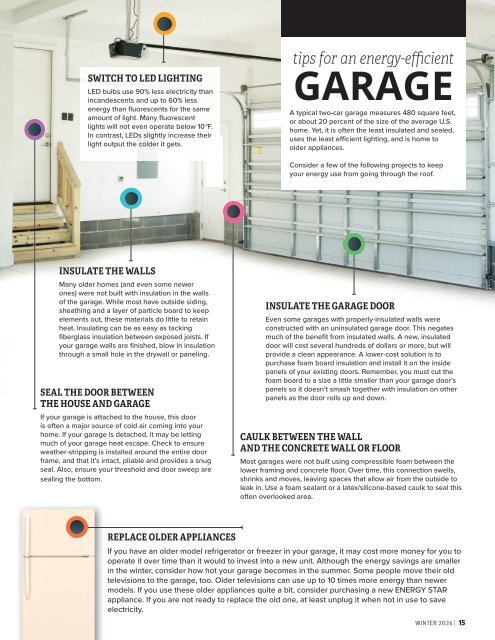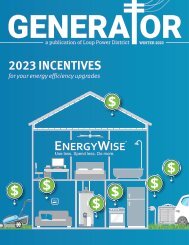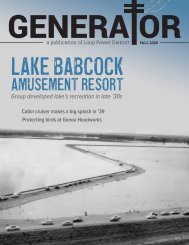Winter 2024 Generator
Topics in this issue include a 2024 rate increase, a lineman's perspective on the power restoration, and 2024 EnergyWise incentives.
Topics in this issue include a 2024 rate increase, a lineman's perspective on the power restoration, and 2024 EnergyWise incentives.
Create successful ePaper yourself
Turn your PDF publications into a flip-book with our unique Google optimized e-Paper software.
SWITCH TO LED LIGHTING<br />
LED bulbs use 90% less electricity than<br />
incandescents and up to 60% less<br />
energy than fluorescents for the same<br />
amount of light. Many fluorescent<br />
lights will not even operate below 10°F.<br />
In contrast, LEDs slightly increase their<br />
light output the colder it gets.<br />
tips for an energy-efficient<br />
GARAGE<br />
A typical two-car garage measures 480 square feet,<br />
or about 20 percent of the size of the average U.S.<br />
home. Yet, it is often the least insulated and sealed,<br />
uses the least efficient lighting, and is home to<br />
older appliances.<br />
Consider a few of the following projects to keep<br />
your energy use from going through the roof.<br />
INSULATE THE WALLS<br />
Many older homes (and even some newer<br />
ones) were not built with insulation in the walls<br />
of the garage. While most have outside siding,<br />
sheathing and a layer of particle board to keep<br />
elements out, these materials do little to retain<br />
heat. Insulating can be as easy as tacking<br />
fiberglass insulation between exposed joists. If<br />
your garage walls are finished, blow in insulation<br />
through a small hole in the drywall or paneling.<br />
SEAL THE DOOR BETWEEN<br />
THE HOUSE AND GARAGE<br />
If your garage is attached to the house, this door<br />
is often a major source of cold air coming into your<br />
home. If your garage is detached, it may be letting<br />
much of your garage heat escape. Check to ensure<br />
weather-stripping is installed around the entire door<br />
frame, and that it’s intact, pliable and provides a snug<br />
seal. Also, ensure your threshold and door sweep are<br />
sealing the bottom.<br />
INSULATE THE GARAGE DOOR<br />
Even some garages with properly-insulated walls were<br />
constructed with an uninsulated garage door. This negates<br />
much of the benefit from insulated walls. A new, insulated<br />
door will cost several hundreds of dollars or more, but will<br />
provide a clean appearance. A lower-cost solution is to<br />
purchase foam board insulation and install it on the inside<br />
panels of your existing doors. Remember, you must cut the<br />
foam board to a size a little smaller than your garage door’s<br />
panels so it doesn’t smash together with insulation on other<br />
panels as the door rolls up and down.<br />
CAULK BETWEEN THE WALL<br />
AND THE CONCRETE WALL OR FLOOR<br />
Most garages were not built using compressible foam between the<br />
lower framing and concrete floor. Over time, this connection swells,<br />
shrinks and moves, leaving spaces that allow air from the outside to<br />
leak in. Use a foam sealant or a latex/silicone-based caulk to seal this<br />
often overlooked area.<br />
REPLACE OLDER APPLIANCES<br />
If you have an older model refrigerator or freezer in your garage, it may cost more money for you to<br />
operate it over time than it would to invest into a new unit. Although the energy savings are smaller<br />
in the winter, consider how hot your garage becomes in the summer. Some people move their old<br />
televisions to the garage, too. Older televisions can use up to 10 times more energy than newer<br />
models. If you use these older appliances quite a bit, consider purchasing a new ENERGY STAR<br />
appliance. If you are not ready to replace the old one, at least unplug it when not in use to save<br />
electricity.<br />
WINTER <strong>2024</strong> | 15
















